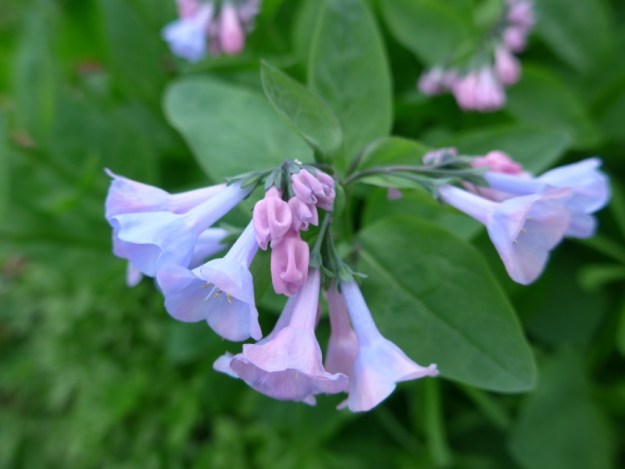 Riverbend Park Bluebell Watch 2017
Riverbend Park Bluebell Watch 2017
It may be only the beginning of March but it’s already spring. The Cherry Blossoms are projected to be at peak bloom by the middle of March and our own Virginia Bluebells are already showing their colors. The floodplain is covered in the light green Bluebell leaves and some plants are even blooming. On February 22, a sunny 65 degree day, a couple of Spring Beauties (Claytonia virginica) were already in bloom and many Virginia Bluebells were pushing their purple shoots up through the sandy soil along the banks of the Potomac River. Now, after an unusually warm week, the beautiful, blue, bell-shaped flowers are showing up all along the floodplain. Those same Bluebell plants did not begin blooming until mid-March in 2016.
The tiny purple shoots that emerge from the soil soon become greenish leaves
Within days the first flower buds can be seen
Joining the Bluebells and Spring Beauty in this early spring are many other spring ephemerals. Harbinger of Spring (Erigenia bulbosa), and Cut leaf Toothwort (Cardamine concatenata) carpet the drier slopes at the edges of the floodplain. Red Maple trees (Acer rubrum) are in full bloom, turning the riverbank canopy a lovely, warm red color.
A walk along the trails last week revealed many other plants and animals taking advantage of the early warmth. The strange, quacking chorus of hundreds of Wood Frogs (Rana sylvatica) could be heard at Carper’s Pond, accompanied by the lovely, soprano peeps of the Spring Peepers (Pseudacris crucifer), tiny tree frogs that produce a sound that can sometimes be heard up to half a mile away. In the same pond, Eastern Newts (Notophthalmus viridescens) could be seen swimming amongst the decaying leaves below the surface of the water, and several large Painted Turtles (Chrysemys picta) were sunning themselves on the trunk of a fallen tree. At one point I watched a female Mallard duck trying to swallow a Wood Frog. After a few minutes of struggling the last leg of the frog disappeared down the mallard’s throat and she swam off with her mate. 
Along the Potomac River there are more signs of the early spring. Many of our common invasive plants are taking advantage of the sudden warmth to get a jump on the blooming season. Common Chickweed and Lesser Celandine are already blooming and Garlic Mustard and Stinging Nettle leaves are appearing. Invasive plants owe some of their success to their ability to bloom very early in the season and having a very long blooming season – enabling them to make use of all the available pollinators. Speaking of pollinators, the warm weather has brought out many plants and animals but few pollinating insects as yet. Ants, which pollinate many of our native spring ephemerals, can be seen on a warm day and mayflies and stoneflies are beginning to emerge from their watery larval stages. Parts of the Visitor Center are coated in a layer of Box Elder Bugs that spent the winter between the siding boards. A couple of butterflies have been spotted on especially warm days, but no bees or flies as yet.
Perhaps the most exciting event this spring is the new Bald Eagle nest on the tip of Minnehaha Island. The large nest is easily visible from the Potomac Heritage Trail about half a mile upriver from the Visitor Center. The female eagle can often be seen sitting on the nest and the male is a frequent visitor. Listen for their shrill calls as you hike along the river.
Bald Eagle pair at their nest
We may be enjoying the warm weather and sun but for some of our plants and animals it can be too much of a good thing. Some, like the native spring ephemerals, should be able to weather any sudden cold snaps in the coming weeks. Others, like the Wood Frogs and Spring Peepers, that have already laid eggs in local ponds may suffer from a change in the weather. Since those eggs were laid there have been several nights with below freezing temperatures. The unusually dry weather also means that many of our vernal pools are dry, reducing the available ponds for breeding frogs and salamanders.
Every day brings something new as the days get longer and the soil warms, so be sure to check out our trails for more signs of spring, and check this space for Bluebell updates.
Riverbend Park will be presenting several naturalist led wildflower walks this spring, beginning on March 29, at both Riverbend Park and Scotts Run Nature Preserve. These walks are a great way to get to know some of our native spring ephemerals and learn some of the folklore associated with them. Our fifth annual Bluebell Festival will be held at Riverbend Park on Saturday April 15, 2017, from 10 a.m. to 2 p.m. and will feature guided wildflower walks, children’s activities, live music, wagon rides, live animal demonstrations, vendors, food and guided wildflower walks.
For more information on these or any of our spring activities call 703-759-9018 or view our website at www.fairfaxcounty.gov/parks/riverbend
Marijke Gate, Naturalist at Riverbend Park










